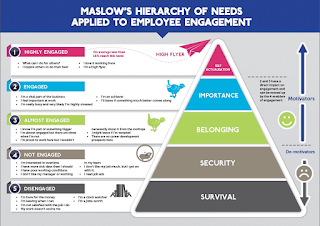 |
| Source: Thompkins-Jones (24 July 2014) |
Researcher John Ballard hunted through the "Maslow archives at the Center for the History of Psychology at the University of Akron in Ohio", and after an extensive and wide-ranging research programme with his fellow authors, Todd Bridgman and Stephen Cummings, "found no trace of Maslow framing his ideas in pyramid form” (2019, p. 82). They further note that up until the 1980s, the preferred model for Maslow's hierarchy of needs was a ladder, where the reader could imagine simultaneous points of contact with different rungs. This ladder framework is more in keeping with what Maslow outlines in his original 1943 paper. Maslow's ideas do not fit a pyramid.
What is also interesting is how Maslow's work transferred from psychology to management. Bridgman et al. state "Douglas McGregor [..] encountered it in 1944 and drew on it in developing his famous Theory X and Theory Y concept" (2019, p. 84). Correspondence which followed between the two academics resulted in McGregor championing the hierarchy of needs; in industry, at conferences, and publishing papers about it. McGregor's interest arose at an opportune time when returned service people were coming back from WW2 in Europe and the Pacific, and enrolling at university. The GI Bill for returned service people included fully-funded MBAs from a grateful American public.
It was McGregor who made Maslow famous, although until the early 1960s, Maslow's thinking which inspired McGregor's Theory X and Theory Y was hidden, unacknowledged, within McGregor's work (Bridgman et al., 2019). Maslow's hierarchy first appears as a demi-ziggurat image by Davis (1957, as cited by Bridgman et al., 2019), and then as a pyramid from McDermid (1960, as cited by Bridgman et al., 2019). Both of models are clearly targeting business readers, being published respectively in Human Relations in Business, and Business Horizons (Bridgman et al., 2019). Maslow is now a management hot property, complete with a shape which means change in mathematics, with the layers of the model named as physiological needs, safety, social, esteem, and self-realisation needs (McDermid, 1960, as cited by Bridgman et al., 2019). Note the changes of rung names from paragraph one.
Many elements got lost as time ticked on, such as Maslow's initial idea that people can be at many stages, all at once (1942). In a later book, Maslow talks about transcendence, which seems to imply there may be a level past that of self-actualisation (1962). Maslow also proposes that, to be healthy and to grow, humans need to use their capacities - such as striving, physiology, intelligence, and love - or potentially may suffer from either physical or psychic disease (1962). These ideas have not been reflected in the pyramid that the management field has adopted.
After the experiences of WW2, Maslow sought peace, yet we have "ignore[d] some of [his] more egalitarian principles" (MacLellan, 2019). Additionally, Maslow had some interesting ideas about women - saying about Mexican women that "one woman is about as good as another, and that she is interchangeable with others. She discovers that she is not valuable; it is the class 'woman' that is valuable" in the eyes of Mexican men (1962, p. 121). Ouch.
Maslow was a free-thinker, and his thinking probably still has value: even if we have not been able to gather research evidence that his model actually works in practice. We do, however, need to remind ourselves that his model is: (a) not a pyramid; (b) not sequential; (c) not absolute; and (d) is not a management model.
If we read what Maslow originally wrote, then it is a useful as a lens to consider what may be holding us - or others - back.
Sam
References:
- Ballard, J.A. (2006). The diffusion of Maslow’s motivation theory in management and other disciplines. Paper presented at the 66th Academy of Management Annual Meeting, Knowledge, Action and the Public Concern,11-16 August, Atlanta GA, USA.
- Bridgman, T., Cummings, S., & Ballard, J. A. (2019). Who Built Maslow’s Pyramid? A History of the Creation of Management Studies’ Most Famous Symbol and Its Implications for Management Education. Academy of Management Learning & Education, 18(1), 81–98. https://doi.org/10.5465/amle.2017.0351
- MacLellan, L. (11 April 2019). Maslow’s pyramid” is based on an elitist misreading of the psychologist's work. https://qz.com/work/1588491/maslow-didnt-make-the-pyramid-that-changed-management-history/
- Maslow, A. H. (1943). A theory of human motivation. Psychological Review, 50(4), 370-96. https://doi.org/10.1037/h0054346
- Maslow, A. H. (1962). Toward a Psychology of Being. D Van Nostrand Company Inc.
- Thompkins-Jones, R. (24 July 2014). Maslow's Hierarchy of Needs Applied to Employee Engagement. https://notesfromanaspiringhumanitarian.com/illustration-applies-maslows-hierarchy-of-needs-to-employee-engagement/

No comments :
Post a Comment
Thanks for your feedback. The elves will post it shortly.